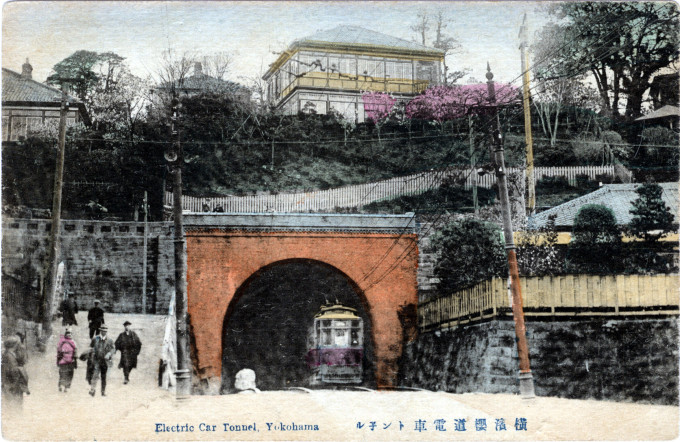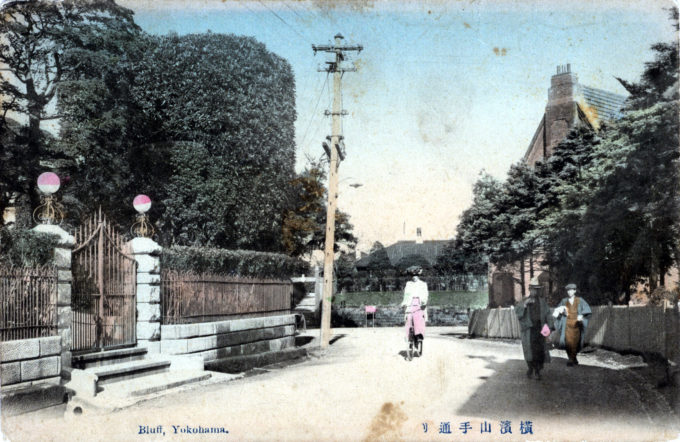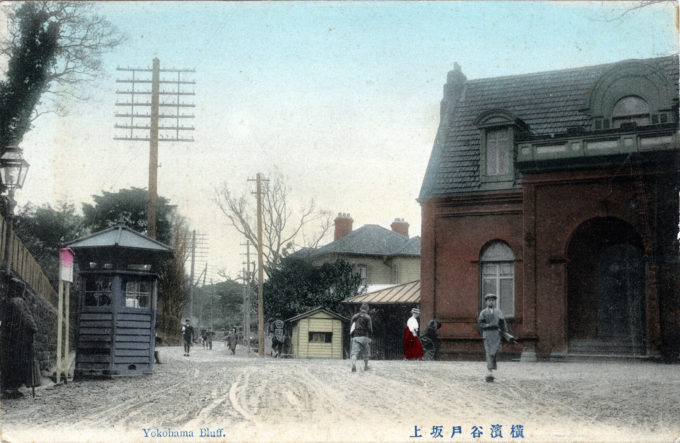
“Electric Car Tunnel”, Yokohama. A streetcar route traveled underneath the Bluff, where many of Yokohama’s expatriates lived, from Motomachi to Honmoku.
See also:
Honmoku, Yokohama, c. 1910
Grand Hotel, Yokohama, c. 1910
Motomachi Street, Yokohama, c. 1910
“The Bluff (Yamate-cho) is a wide and elevated area, 150-ft above the sea at the S side of the Yokohama Settlement, crowned by many pretty dwellings of the foreign residents and crossed and recrossed by many charming flower decked lanes, is one of the handsomest residential sites in the Far East.
“A number of steepish winding roadways lead to it from the creek which delimns the SW border of the commercial town, the most popular being the Yato Zaka, or Camp Hill Road, which passes along the rear of the Grand Hotel and flanks the French consulate .
“… The NE edge of the Bluff falls down steeply to the sea and from the shaded road which crosses it one may enjoy panoramas of extraordinary beauty and extent views of junk-flecked sea restful towns green mountains and the always adorable Fuj-san. Few spots of the world are more charmingly situated and few more generously bedecked with flowers.
“Long flights of crumbling stone steps connect here and there the lower byways with the upper roads and are often overhung with a host of semi tropical flowers and flowering trees. Huge retaining walls (of madrepore) hold many of the houses and gardens in place, and in their interstices grow a wealth of microscopic flora and graceful ferns.
“Here one may see the panicled white flowers of the Isopyrum japonicum and those of the unique Kerria japonica named for William Kerr, a British gardener, cultivated in Europe and America under the erroneous name of Corchorus japonicus. The Public Garden is beautifully laid out In April the lane known as Negishi rnachi is a bower of cherry blooms.
“The region roundabout the Race Course called Negishi and is dotted with the villas of foreign residents. The tram line which runs through a tunnel under the Bluff goes to Honmoku.”
– Terry’s Japanese Empire, T. Philip Terry, 1914

“The Bluff”, Yokohama, c. 1920. A resident bicycling through the foreign community that overlooked Yokohama harbor.
“The foreign population of Yokohama, after reaching 2,400 of all nationalities [ca. 1920], excluding Chinese, remained static. About 1,600 were British and American, the rest Continentals, with a sprinkling of Russians and East Indians. Since the leading Japanese citizens and officials resided in the hills on the other side of the city, there was little opportunity to mingle socially, beyond formal affairs.
“… In the old-world atmosphere of this environment, life became singularly easy-going and tranquil. Home offices having hand-picked their men for service abroad, an unusual degree of congeniality existed. Everyone knew everyone, intimately or casually according to the circumstance. Being, in a sense, isolated from the world, the community had to look within itself for entertainment and recreation.
“… The importance of keeping fit was recognized and office hours allowed plenty of time for recreation, running normally from 9 a.m. to noon and 2 p.m. to 5 p.m. Menfolk were thus able to go home for lunch, via the United Club for the day’s news, a cocktail and, hopefully, a bit of gossip, and in the evening get in some tennis, golk, sailing or some other sport.”
– The Death of Old Yokohama: In the Great Japanese Earthquake of 1923, by Otis M. Poole, 2010


